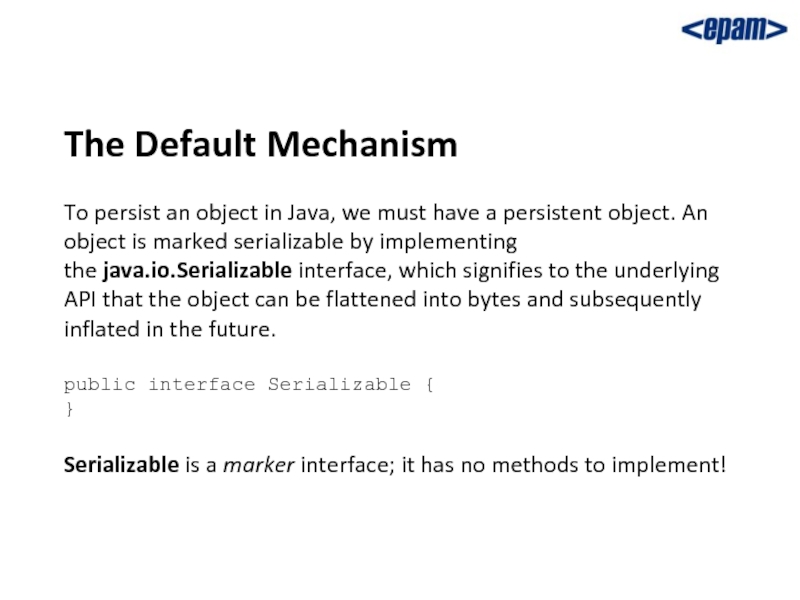- Главная
- Разное
- Дизайн
- Бизнес и предпринимательство
- Аналитика
- Образование
- Развлечения
- Красота и здоровье
- Финансы
- Государство
- Путешествия
- Спорт
- Недвижимость
- Армия
- Графика
- Культурология
- Еда и кулинария
- Лингвистика
- Английский язык
- Астрономия
- Алгебра
- Биология
- География
- Детские презентации
- Информатика
- История
- Литература
- Маркетинг
- Математика
- Медицина
- Менеджмент
- Музыка
- МХК
- Немецкий язык
- ОБЖ
- Обществознание
- Окружающий мир
- Педагогика
- Русский язык
- Технология
- Физика
- Философия
- Химия
- Шаблоны, картинки для презентаций
- Экология
- Экономика
- Юриспруденция
Serialization in Java презентация
Содержание
- 1. Serialization in Java
- 2. Object Serialization We all know the
- 3. Serializable Class is serializable
- 4. Usage RMI Enterprise Java Beans JMS Object Cache (disk storage) Application Server clustering …
- 5. Your own protocol class Box int
- 6. The Default Mechanism To persist an
- 7. Working with ObjectOutputStream and ObjectInputStream ObjectOutputStream.writeObject()
- 8. Bare-bones example import java.io.*; class
- 9. ?
- 10. Object Graphs What if the instance
- 11. What did we forget? import java.io.*;
- 12. Good news! Only objects marked Serializable can be
- 13. Transient What if we didn't have
- 14. Using writeObject and readObject When the
- 15. Serialization Is Not for Statics You
- 16. ?
- 17. Create Your Own Protocol: the Externalizable Interface
- 18. Externalizable package java.io; public interface Externalizable extends
- 19. serialVersionID Used when deserialization for deciding
- 20. Links Java Object Serialization Specification Implementing Serializable: best practices
Слайд 2Object Serialization We all know the Java platform allows us to create
reusable objects in memory. However, all of those objects exist only as long as the Java virtual machine remains running. It would be nice if the objects we create could exist beyond the lifetime of the virtual machine, wouldn't it?
Object serialization is the process of saving an object's state to a sequence of bytes, as well as the process of rebuilding those bytes into a live object at some future time.
Слайд 3Serializable
Class is serializable
if
It can be transformed to array of bytes,
and
re-created from those bytes.
By another class loader
In another JVM
On another computer
Слайд 5Your own protocol
class Box
int height = 5;
int width = 10;
File
class Box
int
height = 10;
int width = 5;
int width = 5;
Слайд 6The Default Mechanism To persist an object in Java, we must have
a persistent object. An object is marked serializable by implementing the java.io.Serializable interface, which signifies to the underlying API that the object can be flattened into bytes and subsequently inflated in the future.
public interface Serializable {
}
Serializable is a marker interface; it has no methods to implement!
Слайд 7Working with ObjectOutputStream and ObjectInputStream ObjectOutputStream.writeObject() // serialize and write ObjectInputStream.readObject() // read
and deserialize
Слайд 8Bare-bones example import java.io.*; class Cat implements Serializable { } // 1 public class
SerializeCat {
public static void main(String[] args) {
Cat c = new Cat(); // 2
try {
FileOutputStream fs = new FileOutputStream("testSer.ser");
ObjectOutputStream os = new ObjectOutputStream(fs);
os.writeObject(c); // 3
os.close();
} catch (Exception e) { e.printStackTrace(); }
try {
FileInputStream fis = new FileInputStream("testSer.ser");
ObjectInputStream ois = new ObjectInputStream(fis);
c = (Cat) ois.readObject(); // 4
ois.close();
} catch (Exception e) { e.printStackTrace(); }
}
}
Слайд 10Object Graphs What if the instance variables are themselves references to objects? class
Dog implements Serializable {
private Collar theCollar;
private int dogSize;
public Dog(Collar collar, int size) {
theCollar = collar;
dogSize = size;
}
public Collar getCollar() { return theCollar; }
}
class Collar {
private int collarSize;
public Collar(int size) { collarSize = size; }
public int getCollarSize() { return collarSize; }
}
Слайд 11What did we forget? import java.io.*; public class SerializeDog { public static void
main(String[] args) {
Collar c = new Collar(3);
Dog d = new Dog(c, 8);
try {
FileOutputStream fs = new FileOutputStream("testSer.ser");
ObjectOutputStream os = new ObjectOutputStream(fs);
os.writeObject(d);
os.close();
} catch (Exception e) { e.printStackTrace(); }
}
}
But when we run this code we get a runtime exception something like this:
java.io.NotSerializableException: Collar
The Collar class must ALSO be Serializable!
Слайд 12Good news! Only objects marked Serializable can be persisted. These classes are already serializable: -
Integer, Double, etc.
- String
- Date, Calendar
- ArrayList, LinkedList, HashSet, HashMap, etc.
Array of serializable objects is also serializable!
Слайд 13Transient What if we didn't have access to the Collar class source
code? In that case, can we ever persist objects of Dog type?
If you mark the Dog's Collar instance variable with transient, then serialization will simply skip the Collar during serialization:
class Dog implements Serializable {
private transient Collar theCollar; // add transient
// the rest of the class as before
}
Слайд 14Using writeObject and readObject When the Dog is deserialized, it comes back
with a null Collar.
class Dog implements Serializable {
transient private Collar theCollar; // we can't serialize this
private int dogSize;
public Dog(Collar collar, int size) {
theCollar = collar;
dogSize = size;
}
public Collar getCollar() { return theCollar; }
private void writeObject(ObjectOutputStream os) {
try {
os.defaultWriteObject(); // 1
os.writeInt(theCollar.getCollarSize()); // 2
} catch (Exception e) { e.printStackTrace(); }
}
private void readObject(ObjectInputStream is) {
try {
is.defaultReadObject(); // 3
theCollar = new Collar(is.readInt()); // 4
} catch (Exception e) { e.printStackTrace(); }
}
}
Слайд 15Serialization Is Not for Statics You should think of static variables purely
as CLASS variables.
Serialization applies only to OBJECTS.
Static variables are NEVER saved as part of the object's state…because they do not belong to the object!
Слайд 17Create Your Own Protocol: the Externalizable Interface Instead of implementing the Serializable interface, you
can implement Externalizable, which contains two methods:
public void writeExternal(ObjectOutput out) throws IOException;
public void readExternal(ObjectInput in) throws IOException,
ClassNotFoundException;
Just override those methods to provide your own protocol. Although it's the more difficult scenario, it's also the most controllable. An example situation for that alternate type of serialization: read and write PDF files with a Java application.
Слайд 18Externalizable
package java.io;
public interface Externalizable extends java.io.Serializable
{
void writeExternal(ObjectOutput out)
throws IOException;
void
readExternal(ObjectInput in)
throws IOException, ClassNotFoundException;
}
throws IOException, ClassNotFoundException;
}
Слайд 19serialVersionID
Used when deserialization for deciding if the serialized and loaded
classes are compatible
If not present, JVM computes this value automatically
If not present, JVM computes this value automatically
[private] static final long serialVersionUID = 42L;










![What did we forget? import java.io.*; public class SerializeDog { public static void main(String[] args)](/img/tmb/2/111984/a04d13c287b1202ee2fa31ad141db3ce-800x.jpg)














